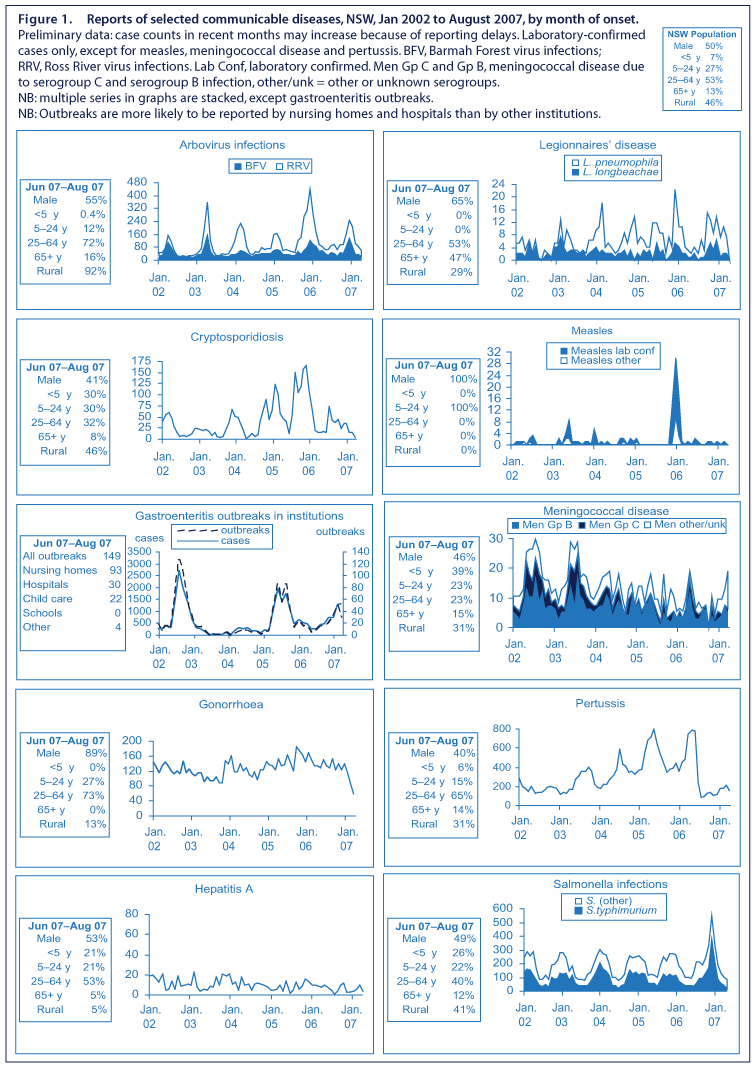Communicable Diseases Report, New South Wales, July and August 2007
Communicable Diseases Branch, NSW Department of Health
NSW Public Health Bulletin 18(10) 203-207 https://doi.org/10.1071/NB07111
Published: 26 September 2007
For updated information, including data and facts on specific diseases, visit www.health.nsw.gov.au and click on Infectious Diseases.
Tables 1 and 2 and Figure 1 show reports of communicable diseases received through to the end of July and August 2007 in NSW.

|

|
Influenza
NSW Health’s influenza surveillance program monitors the rate of people presenting to selected emergency departments (EDs) with influenza-like illness, and the rate of specimens received by six major laboratories that test positive for influenza.
In July reports from EDs initially peaked in the middle of the month at very high levels (6.6/1000 presentations) before a short-lived decline. Influenza outbreaks were reported from 12 residential care facilities, three military facilities and one boarding school, across six of the eight area health services.
In August reports from EDs increased again, and peaked in the middle of the month at even higher levels (9/1000 presentations) before declining. Laboratories reported testing large volumes of specimens for influenza throughout August. Influenza outbreaks were reported from 16 residential care facilities, across six of the eight area health services. Greater Western Area Health Service reported that a 2-year-old boy died after a brief febrile illness. Tests of respiratory samples taken after death were positive for influenza A. For more information see http://www.health.nsw.gov.au/infect/pdf/flureport.pdf.
Meningococcal disease
In July, 11 cases of meningococcal disease were reported in NSW (seven females and four males). Of these, none were caused by infection with serogroup C and five were caused by serogroup B meningococci bacteria. One death was reported. In August, 21 cases were reported (10 males and 11 females). Of these one was due to serogroup C and seven were due to serogroup B meningococci bacteria. No deaths were reported. In total, 69 cases of meningococcal disease have been notified in NSW in 2007, including two deaths. The number of reports in 2007 is similar to 2006.
Syphilis
There has been an increase in reports of infectious syphilis in NSW since the last quarter of 2006 (see: http://www.health.nsw.gov.au/data/diseases/syphilis.html. Cases have been predominantly among men living in central and eastern Sydney, and although risk factors are not routinely collected on cases, discussions with clinicians indicate that many cases are in men who have sex with men.
Enterics
In July, NSW public health units investigated 53 outbreaks of gastroenteritis. Eight were suspected food-borne outbreaks. Four of these (affecting between three and five people) were associated with restaurant meals and were consistent with viral infection transmitted via food. For the other four, investigators suspected that the outbreaks were spread from person-to-person rather than via food.
Person-to-person spread of viral gastroenteritis was also the most likely cause of the other 45 outbreaks, all reported from institutions. Twenty-six outbreaks were reported in aged care facilities and affected more than 500 people. Fourteen outbreaks were reported in hospitals and affected almost 300 people. Four outbreaks were reported in child care centres and one and in a camp setting.
In August, NSW public health units investigated 63 outbreaks of gastroenteritis. Among these were three suspected food-borne outbreaks. Of these, two were associated with restaurants and affected between two and five people. Both restaurants were inspected by the NSW Food Authority. The cause of these outbreaks was not determined. The third was in an institutional setting and affected approximately 30 people. Symptoms were consistent with food-borne disease but a source of the outbreak was unable to be identified. The outbreak was investigated primarily by on-site personnel with support from the Public Health Unit.
Person-to-person spread of viral gastroenteritis was the most likely cause of the other 60 outbreaks, all reported from institutions. Of these, 44 were reported in aged-care facilities and affected more than 670 people, 11 were reported in hospitals and affected more than 100 people, and five were reported in child care centres and affected 39 children.
Viral gastroenteritis is common in the winter months. Norovirus and rotavirus are common causes of gastroenteritis and can be prevented by simple measures such as hand washing with soap and water. For further information and recommendations on outbreak control including ‘Gastro Packs’ for use in aged care and hospital facilities, go to: http://www.health.nsw.gov.au/infect/diseases.html and scroll down to ‘Gastroenteritis (viral)’. Fewer outbreaks have been report over winter 2007 (n = 149) compared with winter 2006 (n = 184).


